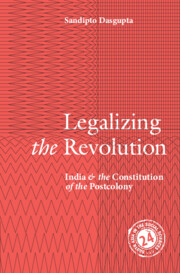Book contents
4 - The Constituent Administrator
Published online by Cambridge University Press: 07 May 2024
Summary
Calculators, it is now up to you: count, measure, compare.
—Jean-Jacques Rousseau, The Social ContractThe class war will find me on the side of the educated bourgeoisie.
—John Maynard Keynes, ‘Am I a Liberal?’There are two things that the British have left behind for us. One is the efficiency of the civil services and the other is the rule of law.
—P. Subbarayan, Constituent Assembly Debates,25 November 1949In 1949, S. Sampurnanand, a minister in the government of the United Provinces, was addressing a convocation of students in the city of Agra. His subject was the nearly completed constitution, which was being drafted only a few hundred kilometres to the west in Delhi. That constitution, he remarked, should have had ‘something of a sacred character which inspires future generations. It is in the case of important States the embodiment of a living faith, the philosophy of life of those who framed it.’ However, ‘judged by this criterion’, the soon-to-be constitution ‘is a miserable failure.… It is just a piece of legislation like, say, the Motor Vehicles Act.’ The Indian constitution did not actually say much about motor vehicles or how to regulate them. For Sampurnanand, what it did share with that most routine of administrative statutes was its style. The constitution ran into several pages and contained an extraordinary amount of detail. It had 395 articles, each with numerous sub articles and halting caveats, not to mention eight lengthy ‘Schedules’, totalling to 146,000 or so words, making it the lengthiest national constitution by a fair margin. Constitutions, as per the Congress socialist Sampurnanand, were meant to be animated by the ‘living faith’ of revolutionary founders, not weighed down by detailed manuals on how to operate the complex machineries of the state. They should be crafted by inspirational assertions of exemplary lawgivers instead of being burdened with the meticulous calculations of administrators. Sampurnanand's criticism was dismissed by the members of the assembly. And it has not fared any better in the seven decades since. Of all the many, many words written to discuss and analyse the Indian constitution, few, if any, acknowledge Sampurnanand, or his line of criticism.
- Type
- Chapter
- Information
- Legalizing the RevolutionIndia and the Constitution of the Postcolony, pp. 141 - 172Publisher: Cambridge University PressPrint publication year: 2024



